В каталоге магазина в Москве представлен большой выбор одежды и снаряжения. [url=http://specodegdaoptom.ru/]магазин спецодежды рядом со мной[/url] Смотрите по ссылке -…
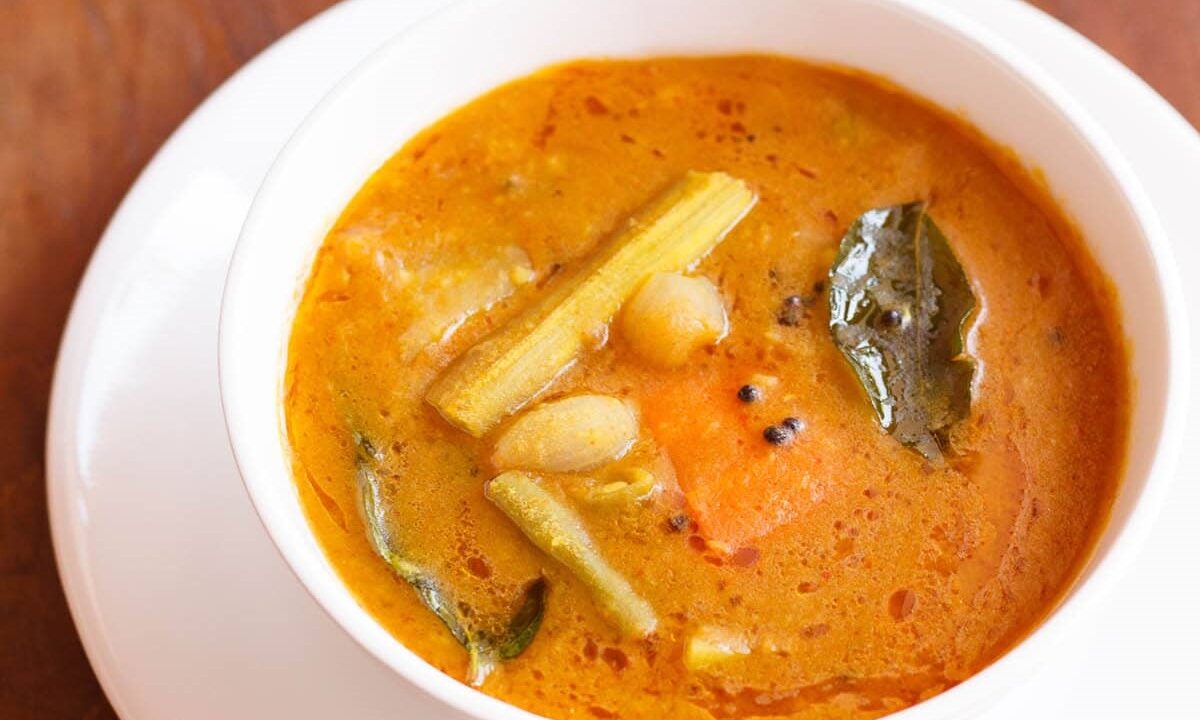
Sambar is a South Indian lentil and vegetable stew made with pigeon pea lentils, tamarind and a unique spice blend called sambar powder. It is a staple dish in South Indian homes and is also equally popular and loved by many.
A basic sambar recipe will have a mix or one or two types of vegetables along with lentils, tamarind, sambar powder and a few spices.
A good sambar powder always yields a good and tasty sambar. so when you make it, try to have a good aromatic sambar powder.
You can also use your favorite brand of sambar powder. I make Sambar Powder at home and I feel homemade sambar powder gives the best and perfect taste in sambar.
If you live outside India and are new to Indian cuisine, then you can find Sambar powder online on amazon or you even find it in an Indian grocery store.
It is healthy as well as nutritious being rich in protein and also other nutrients like vitamins, minerals etc as its made from both lentils and vegetables. Sambar served with rice or idli makes up for a complete meal.
I usually make sambar with this recipe as it is a foolproof method – where both the lentils and vegetables are cooked to perfection. So you do not get half cooked lentils or mushy pasty vegetables. It is also an easy method of making sambar recipe.
I usually add a mix of vegetables from the list mentioned above or just one vegetable in the sambhar. In this sambar recipe, I have added drumstick, okra, pumpkin, carrots, brinjals, french beans and small onions (shallots or pearl onions).
Choice of Lentils
- Traditionally sambar is always made with tur dal (arhar dal or pigeon pea lentils).
- Even moong dal (yellow mung lentils) or masoor dal (orange lentils) can be used to make sambhar.
- A mix of tur dal and masoor dal can also be used. On occasions, I also make sambar recipe with only mung dal.
- You can also use a combination of tuvar dal and moong dal.
- In some variations, black eyed beans and whole moong beans are also included.
Choice of Vegetables
Sambar can be made with just one vegetable or a mix of vegetables. The vegetables that can be used alone or in combination are listed below. From the below list you can have a combination of vegetables.
If using greens like spinach or amaranth, then just add them exclusively and do not mix with other vegetables. You can also add your choice of veggies to the sambar recipe.
| English | Hindi |
|---|---|
| Yellow pumpkin | Kaddu |
| Carrot | Gajar |
| Ash gourd (white pumpkin) | Petha |
| Drumstick | Saijan ki phalli |
| Pearl onions, shallots, onions | Chote pyaaz ya pyaaz |
| Radish | Mooli |
| Tomato | Tamatar |
| Okra (lady fingers) | Bhindi |
| Potatoes | Aloo |
| Brinjals (eggplant) | Baingan |
| Snake gourd | Chichinda |
| Spinach | Palak |
| Amaranth leaves | Chaulai |
| Bottle gourd | Lauki, dudhi, ghiya |
| Banana stem | Kele ka tana |
| Plantain (unripe raw banana) | Kacha kela |
| Green beans (french beans) | Faraz bean |
| Ivy gourd | Tindora, tendli |
| Field marrow (Mangalore cucumber) | Madras cucumber |

How to make Sambar
Sambar recipe includes a series of preparations, that are all assembled later together. So you need to make the tamarind pulp, cook vegetables and lentils. Lets begin.
Make Tamarind Pulp
1. Before we begin making sambar, it always helps to soak tamarind in water earlier. So soak 1 tablespoon tamarind in ⅓ cup hot water for 20 to 30 minutes.
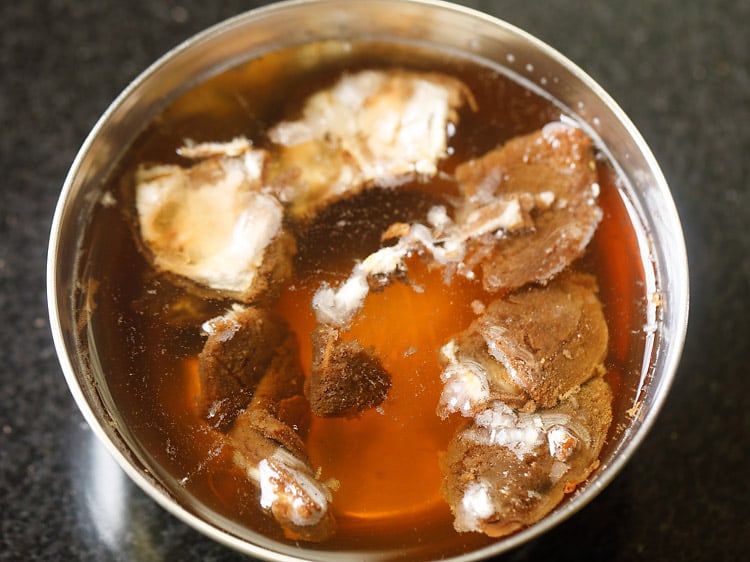
2. Once the tamarind gets soft, then squeeze the tamarind in the water itself. Discard the strained tamarind and keep the tamarind pulp aside.
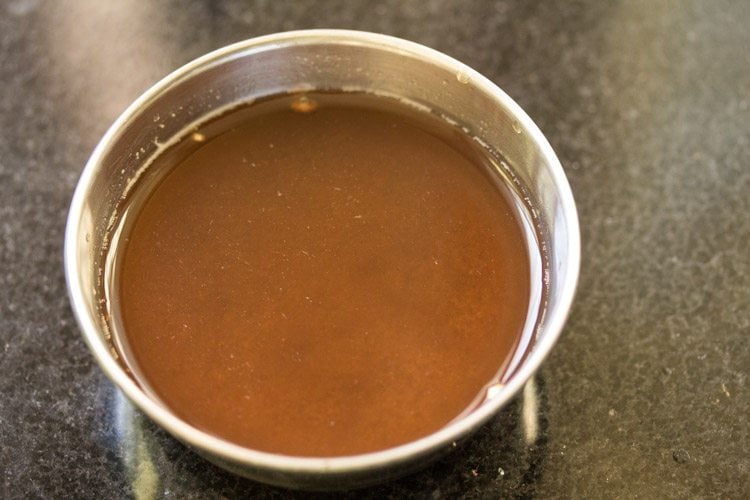
Cook Lentils
3. Rinse ½ cup tuvar dal (100 grams) a couple of times in fresh and clean water. You can use a strainer to rinse the lentils. For quick cooking of the lentils you can opt to soak them for an hour prior to cooking.
I recommend to make your sambar recipe with unpolished tuvar dal for a really good taste and more nutrition.
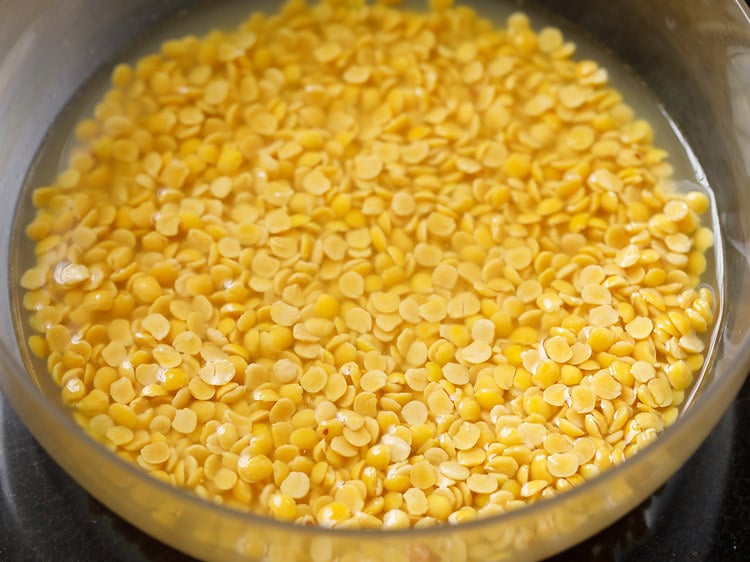
4. Drain all the water and add the dal in a 2 litre pressure cooker. Also add ¼ teaspoon turmeric powder.
Note: You can also cook the lentils in a pan or instant pot. Add water as needed while cooking the lentils.

5. Add 1.5 to 1.75 cups of water and mix.

6. Cover and pressure cook dal for 7 to 8 whistles or 9 to 10 minutes on medium heat.
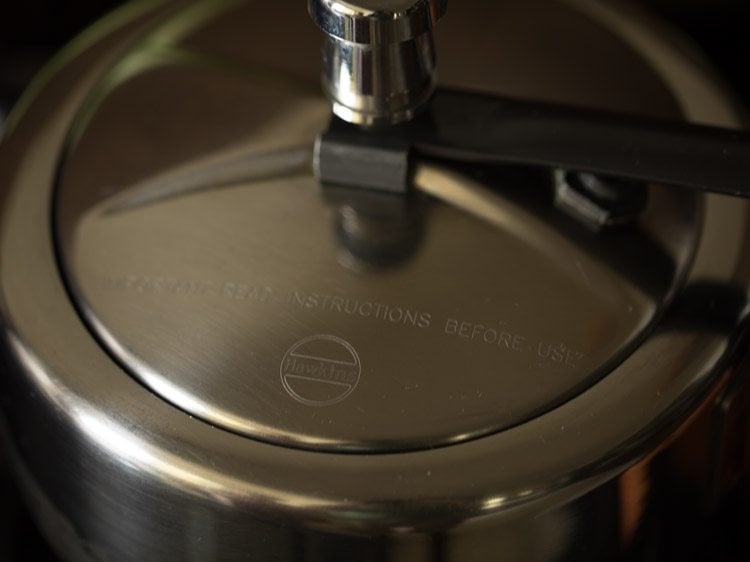
7. When the pressure settles down on its own, open the lid and check the dal. The dal should be completely cooked and mushy. mash the dal with a spoon or wired whisk. Cover and keep aside. You can see the consistency of dal in the picture below.

Cook Vegetables
8. When the dal is pressure cooking – rinse, peel and chop the vegetables. When making sambar, chop the vegetables which get cooked faster in large sizes like pumpkin, brinjals (small aubergines) okra, drumsticks etc.
Vegetables which take more time to cook are to be chopped in small sizes like carrots, potatoes, etc. I have chopped the pumpkin in large cubes and the carrots and potatoes in small cubes.
Chop the brinjals before you add them in the pan or else they darken. You will need 1 to 1.5 cup of chopped vegetables.
Note: For best taste and health reasons, I always make sambar with fresh vegetables. However you can use frozen vegetables also.

9. Take 1 to 1.5 cups chopped vegetables in a pan or pot. Also add 6 to 7 pearl onions or 1 small to medium onion (thickly sliced) and 1 small to medium tomato (quartered).

10. Sprinkle ¼ teaspoon turmeric powder, ¼ teaspoon kashmiri red chilli powder and salt as per taste. Adding kashmiri red chili powder is optional and can be skipped. I add it for a nice bright color in the sambar.

11. Add 1.5 to 2 cups water and stir. Add enough water so that they cover the vegetables.
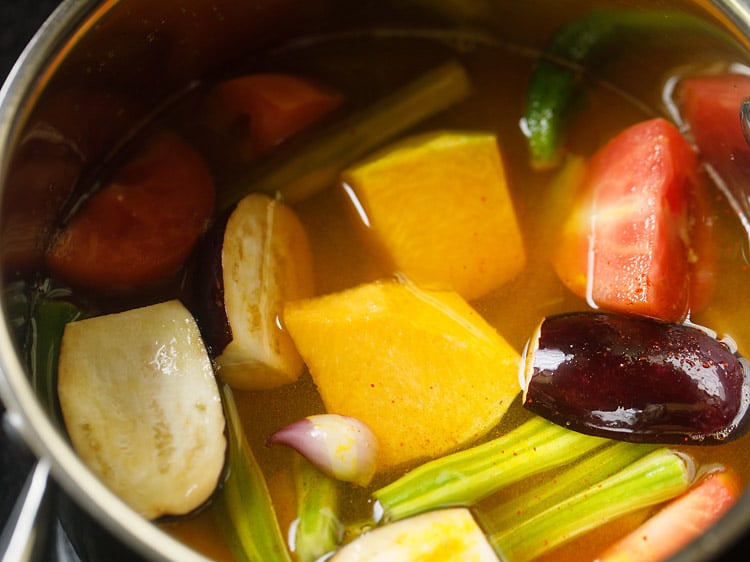
12. Keep the pan on a stove top and begin to cook vegetables on a medium-low to medium flame. in between do check when the vegetables are cooking.

13. Cook till the vegetables are almost done. Ensure that you don’t overcook the vegetables.

Make Sambar
14. Add the prepared tamarind pulp to the cooked vegetables. If you don’t have dried tamarind then use packaged or bottled tamarind paste. You can add about ½ to 1 tablespoon of the tamarind paste or add as according to your taste.
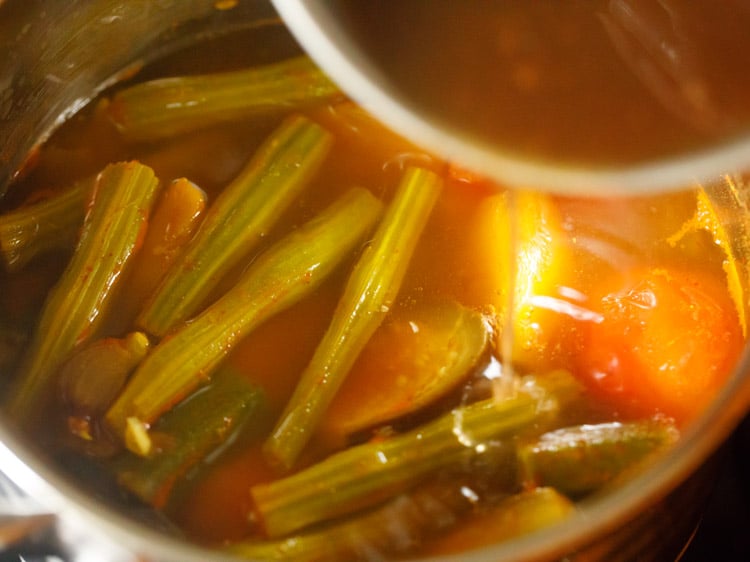
15. Mix well.

16. Next add 1 to 1.5 tablespoons Sambar Powder. At this step you can also add ½ to 1 teaspoon of jaggery powder. Adding jaggery is optional.
The flavor of your sambar mostly depends upon the sambar powder that you will be using. So either make your own homemade sambar powder or use a trusted brand. You can buy packaged sambar powder easily online.

17. Stir and mix well again.

18. Add the mashed dal.

19. Mix very well. If the consistency looks very thick, you can add some water. You can easily adjust the quantity of water and make medium to thin consistency of sambar. But keep in mind not to add too much of water as this will dilute the flavors.
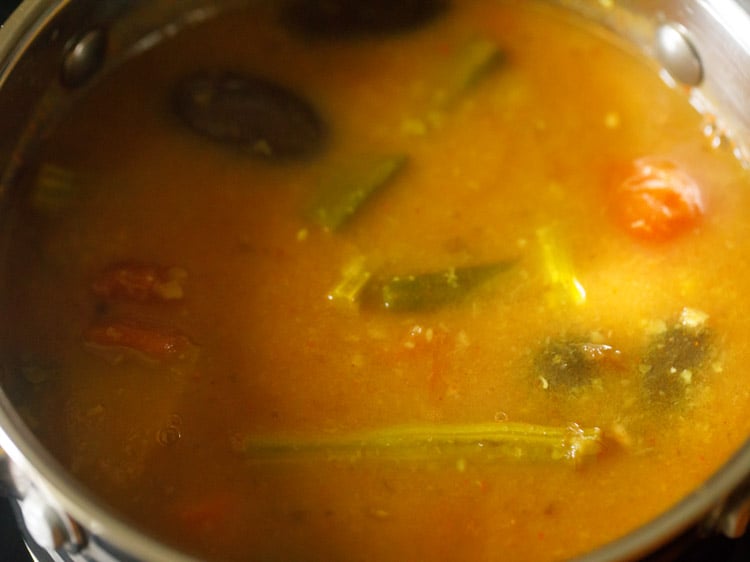
20. Simmer on a medium-low flame till it comes to a boil. Stir at intervals. You will see a frothy layer on top when the sambar begins boiling.
At this step switch off the heat. Cover and keep aside. Check the taste and add salt if required.
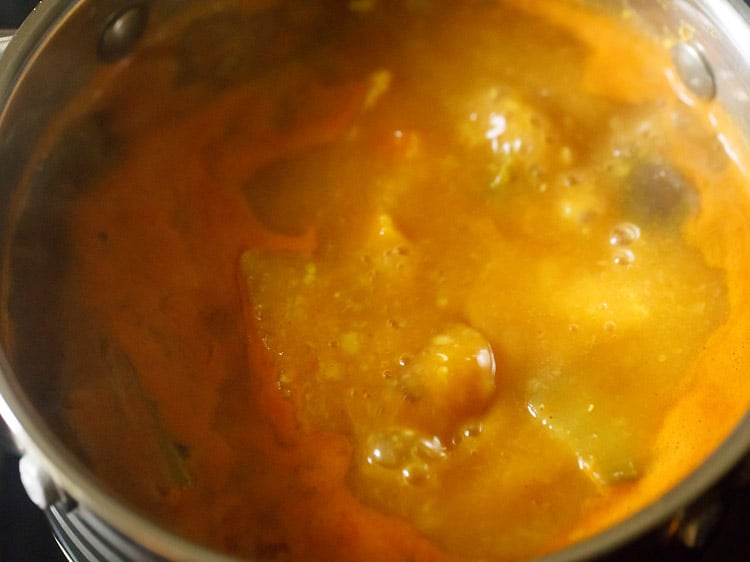
Temper Sambar
21. In a small pan or tadka pan, heat 2 tablespoons gingelly oil (oil made from raw sesame seeds).
You can even use sunflower oil, ghee or coconut oil instead. Add ½ tsp mustard seeds.
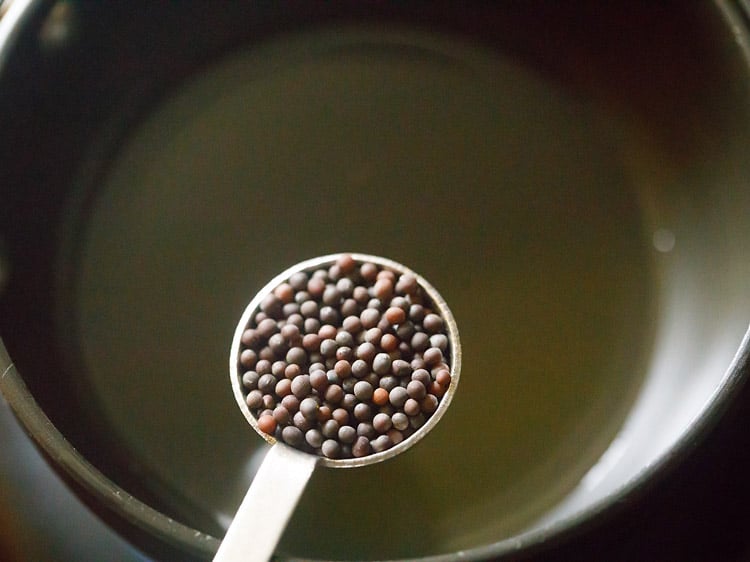
22. Let the mustard seeds crackle.

23. Then add 1 to 2 dry red chillies (halved and seeds removed).
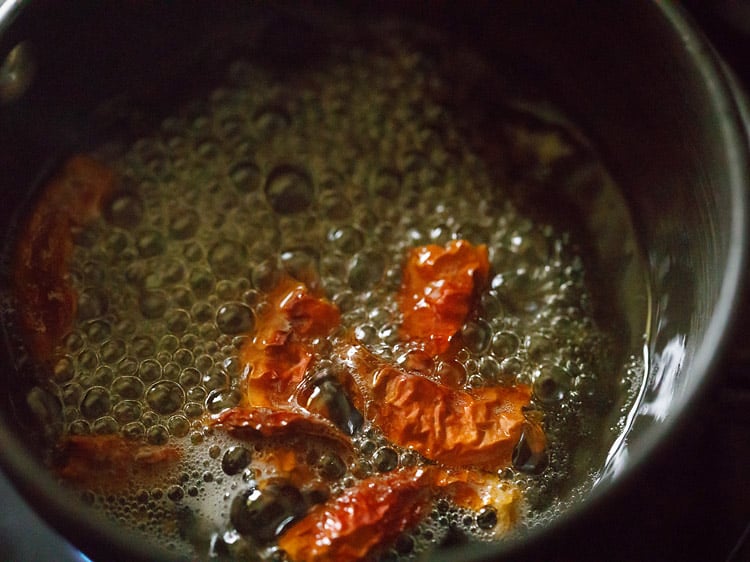
24. Immediately add 10 to 12 curry leaves, 5 to 6 fenugreek seeds (methi seeds) and 2 pinches of asafoetida (hing). Be careful while adding curry leaves as the oil splutters a lot.
Note: To make sambar gluten-free, omit the asafetida and ensure that your sambar powder does not have asafetida or use gluten-free asafetida.

25. Fry them till the red chilies change color and curry leaves become crisp.
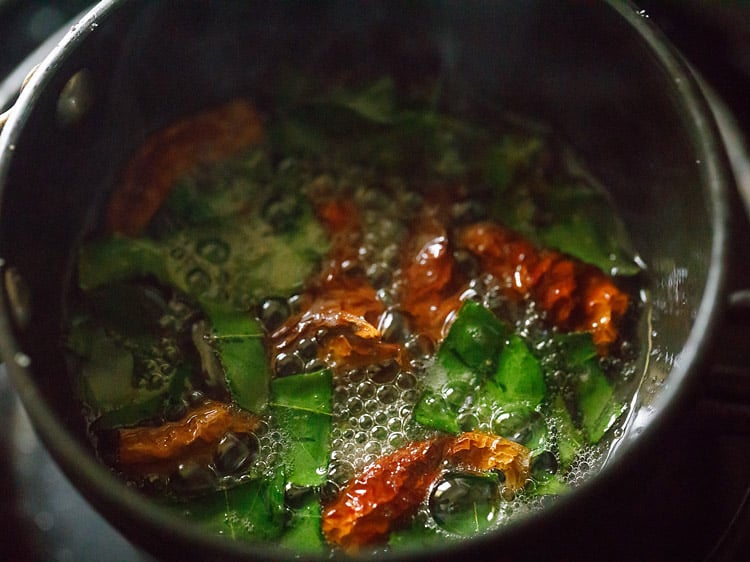
26. Immediately add this tempering mixture in the hot sambar.
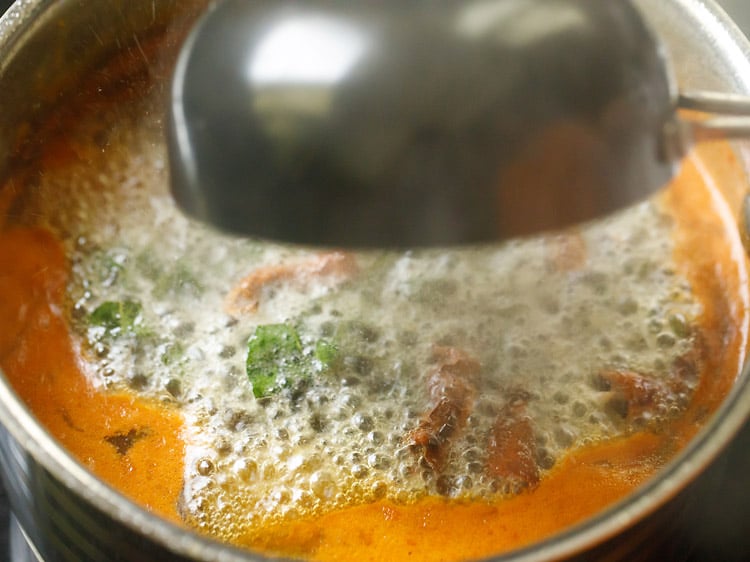
27. Cover the pan with its lid for 4 to 5 minutes, so that the aroma and flavors from the tempering mixture get infused with the sambar.

28. Serve sambar hot or warm. Garnish with some coriander leaves if you prefer. Usually, it is is cooked a two-three hours earlier as its taste becomes better with time.
However, we prefer sambar to be served as soon as it is made. It can also be served with steamed rice, idli, dosa, medu vada or uttapam.
Serving Suggestions
Sambar is served with steamed rice, idli, dosa or medu vadai or uttapam. You can vary the consistency of sambhar and serve it with whatever dish you are making like idli or dosa or rice.
A slightly thin sambhar is served with idli, dosa and medu vada. Medium to thick consistency sambar is served with steamed rice.
Storage and Leftovers
Store sambar in the refrigerator for a day only. The consistency will thicken after refrigeration. Add some water and mix to get your desired consistency and reheat in a pan.
Variations
There are many variations for making sambhar. Each South Indian state has some variations like adding a specific oil or adding a few more ingredients or spices in the sambar powder.
- In Tamil Nadu sesame oil which is also called as gingelly is used. Gingelly oil is made from raw sesame seeds and is very different in flavors and taste from the asian toasted sesame oil. In Kerala, coconut oil is used often.
- Some sambar recipe variations have making a ground sambar masala paste with or without coconut. In some variations the coconut is roasted till it is golden and then ground to a paste. So depending on the ingredients used, the sambar recipe will have a different taste and flavor.
- In Karnataka, a bit of jaggery is added in the sambar powder. This gives the sambar a faint sweet taste which some people like.
- Mostly pigeon pea lentils (arhar dal, tur dal, tuvar dal) are used when making sambar recipe. But in some variations red lentils (masoor dal) and yellow moong lentils (mung dal) can also be used. A combination of these three lentils can also be added. I mostly make with arhar dal and moong dal.
Expert Tips
Sambar can be made really flavorful and tasty if you follow some of my handy tips listed below.
- Sambar Powder: The main flavor and aroma of sambar come from using a good and fresh sambar powder. So always use a homemade sambar powder or you can use your favorite brand of sambar powder.
- Type of vegetables: Another flavor and taste elements in the sambar recipe come from the addition of vegetables. So depending on the type of vegetables used, the sambhar will taste different. Personally I prefer a mix of drumsticks, brinjals, pumpkin or ash gourd, pearl onions (shallots), carrots and okra.
- Quality of lentils: Always use a good quality and fresh tuvar dal. The fresher the dal is the better it tastes and cooks faster. For quicker cooking you can soak the lentils for an hour before cooking.
- Tamarind: For tamarind, it is better to use fresh tamarind. If you use aged tamarind, then it will be darker in color and more sour. So add a bit less tamarind than what is mentioned in this recipe.
- Cooking vegetables: Always cook the vegetables till they are done but whole. They should not break or become a mush in the sambar. So when cooking, add vegetables which cook slower first and cook them for some minutes. Then add vegetables which cook faster.
- Oils: Both gingelly oil (raw sesame oil) and edible coconut oil give a really good taste in sambaar. If you do not have these oils, then you can even use sunflower oil or peanut oil.
- Frying spices: While doing the tempering or tadka, always fry on a low flame and stir regularly. The spices and herbs fry fast, so you have to be attentive. If the tempering gets burned, then discard it and make a new tempering. Never add a burnt tempering in sambar as it will spoil the entire taste.
- Consistency: By adding less or more water, you can change the consistency of sambar. But do not add too much water and make it thin as then the flavors and taste gets diluted. For serving with rice you can make a thick sambhar and for serving with idli or dosa, you can make a medium consistency sambar.
- Balancing sourness: In case if you find the taste of sambar more sour, then you can always balance the sour taste by adding a bit of jaggery.



